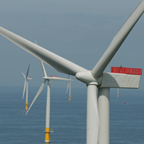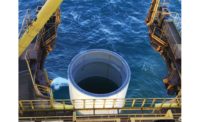
The owner of one of the world’s largest offshore wind farms, located more than 20 kilometers off the coast of England, has lodged a large claim against the contractor, Fluor Corp., for delayed completion due to defective construction.
The claim is reportedly at least as large as the $480 million claim Fluor already has filed against the owner, Greater Gabbard Offshore Winds Ltd., also for delays over the 504-MW project in the outer Thames Estuary.
Originally set for completion by 2011, the wind farm is now not due to be fully operational until later this year, according to Edinburgh, Scotland-based utility SSE plc. SSE owns the project equally with the U.K. subsidiary of Germany’s RWE Innogy GmbH., Essen.
SSE attributes much of the delay to unspecified welding defects in the first 52 of 140 large-diameter steel-tube foundations of the field’s turbines, set in water up to 32 meters deep. The steelwork forms a key part of Fluor’s $1.8-billion lump-sum, turnkey contract.
“We’re right, they’re wrong,” Fluor CEO David Seaton told ENR earlier this month. “Mediation is to start this summer on this. I’m confident in our technical positions relative to the claim.”
Fluor made provisions of $343 million for liabilities on the Greater Gabbard job in its 2010 financial results and another $60 million last year, according to company filings. Fluor’s claim volume reached $265 million at the end of 2011, and the meter is still running.
SSE first announced the discovery of welding problems in late 2009 after Fluor’s Netherlands-based subcontractor, Seaway Heavy Lifting B.V., Zoetermeer, had started installing monopiles. The remaining monopiles went in during summer 2010.
Greater Gabbard’s monopiles are steel tubes up to 6.3 meters in diameter that each weigh nearly 700 tonnes. Individual monopiles were driven into the seabed to support a single turbine. Each monopile is topped with a transition piece that rises out of the water and forms a base for the turbine tower.
Following an investigation last October, SSE reported that some of 52 defective monopiles had been repaired before their installation. Other monopiles and all of the initial 52 transition pieces remain defective, the utility claims.
Shanghai Zhenhua Heavy Industries Co. Ltd. fabricated the monopiles and their transition pieces in China and shipped them to the Netherlands. Copenhagen-based Ramboll Group was the foundation designer.
The grouted interface between the monopiles and the transition pieces has caused problems with numerous North Sea wind-power projects (ENR 5/17/10 p. 14). But this grouting defect does not appear to be the main cause of delay on the Greater Gabbard project.
Fluor and Dublin-based renewable-energy developer Airtricity Holding Ltd. had created Greater Gabbard Offshore Winds Ltd. more than a decade ago to develop and procure the project. The team retained ownership until it secured necessary permitting and procured financing and construction contracts.
Fluor then sold its interest in the project to SSE in May 2008 after all the contracts, including the turnkey agreement, were sealed. SSE became sole owner after it had acquired Airtricity. However, SSE then sold a 50% interest to RWE later that year.



Post a comment to this article
Report Abusive Comment